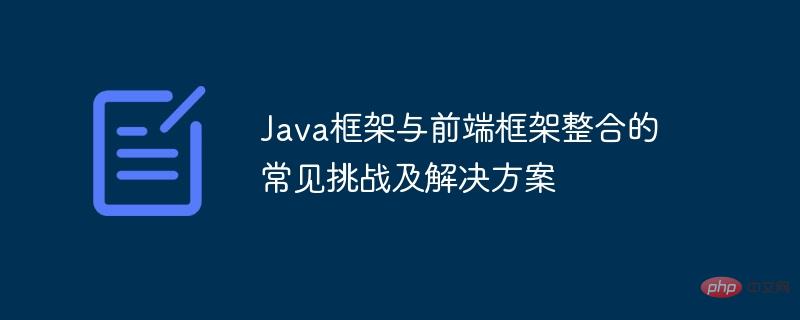Home >Java >javaTutorial >Common challenges and solutions for integrating Java frameworks and front-end frameworks
Common challenges and solutions for integrating Java frameworks and front-end frameworks
- WBOYWBOYWBOYWBOYWBOYWBOYWBOYWBOYWBOYWBOYWBOYWBOYWBOriginal
- 2024-06-05 13:30:10472browse
Common challenges in integrating Java back-end frameworks with front-end frameworks include: Cross-domain request issues: Solution: Use CORS middleware or add CORS headers. View Template Integration: Solution: Use a front-end framework adapter or serverless function to handle HTML rendering. Data format conversion: Solution: Use a common data model or middle layer for conversion. Event handling: Solution: Use event bus or WebSockets for cross-frame event communication. State Management: Solution: Use a single state management system to share state across frameworks.

Common challenges and solutions for integrating Java frameworks and front-end frameworks
In the development of web applications, integrate Java back-end frameworks and front-end frameworks into It's important. However, the process can come with some challenges. Here are some common challenges and their solutions:
Cross-Origin Request Issues (CORS)
- Challenge:Between backend and frontend applications with different domain names Communication between them is subject to browser security restrictions.
- Solution: Use CORS middleware or add CORS headers on the backend to allow the frontend to access the backend API from its domain.
View Template Integration
- Challenge: Backend framework generates HTML views, while frontend framework uses its own template engine.
- Solution: Use the front-end framework adapter available in the back-end template engine, or use a serverless function to handle HTML rendering.
Data format conversion
- Challenges: Backend and frontend applications may use different data formats (such as JSON, XML).
- Solution: Use a common data model or middle layer to convert between different formats.
Event processing
- Challenges: The back-end and front-end event processing mechanisms are different, making it difficult to trigger and process events across frameworks.
- Solution: Use event bus or WebSockets to achieve cross-frame event communication.
State Management
- Challenges: In complex applications, managing front-end and back-end state can be difficult.
- Solution: Use a single state management system (such as Redux, Vuex) to achieve cross-framework state sharing.
Practical case:
Consider an application that uses SpringBoot and React for Java and front-end integration.
- Use CORS middleware on the SpringBoot backend to handle cross-domain requests.
- Use the Thymeleaf template engine and integrate the React adapter to render the React view on the backend.
- Use the Jackson library to convert Java objects to JSON and return it to the front end.
- Use Redux to achieve front-end status management.
- Use WebSockets to establish real-time communication between the backend and frontend.
The above is the detailed content of Common challenges and solutions for integrating Java frameworks and front-end frameworks. For more information, please follow other related articles on the PHP Chinese website!

